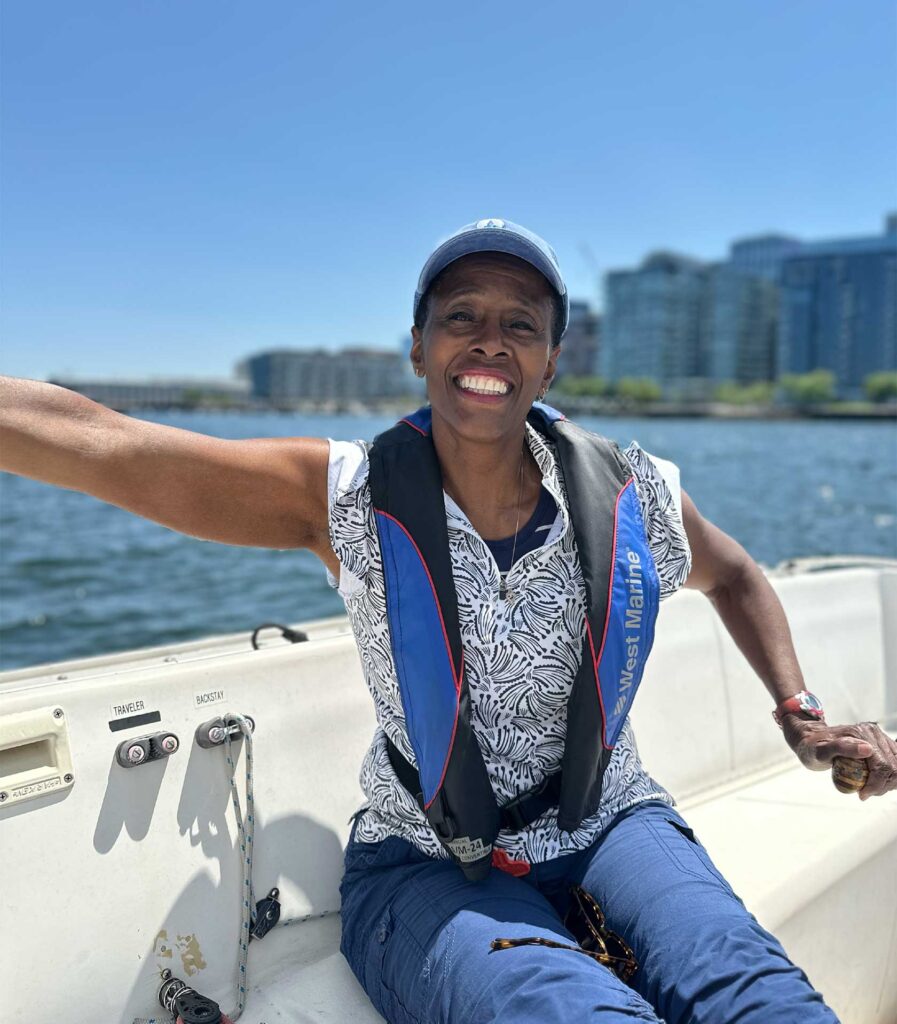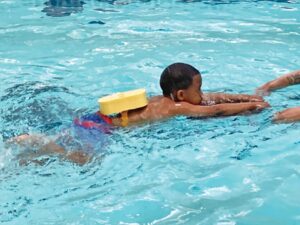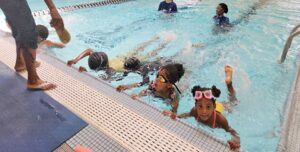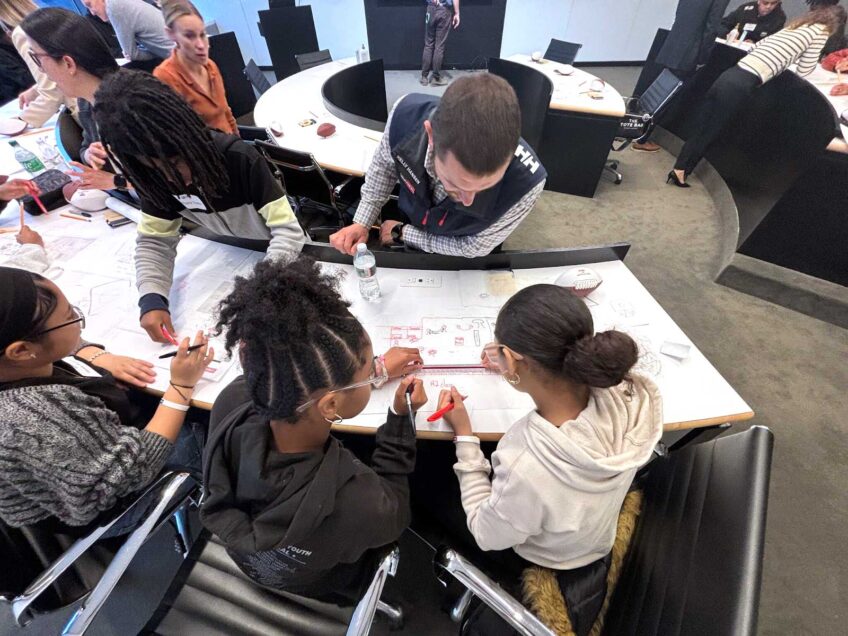
In her fifties, Benadette Manning made the decision to be a triathlete. She began focusing on her training, which included running, biking and swimming. However, when she began going to triathlons, she noticed that there were rarely any other Black people or people of color besides herself in attendance.
Curious, she began researching why this was and discovered that many Black people and other people of color were not participating because they did not know how to swim.
Growing tired of hearing about Black people drowning, Manning created Swim Freedom, a nonprofit with the mission of working to “eliminate drowning” by providing no cost or low-cost swimming lessons for new or non-swimmers.
Manning spoke more about her nonprofit organization and her vision for the company.
“We’ve just celebrated our one-year anniversary. … I always like talking about the vision because I get so excited. We want to eliminate drowning, and that’s a big vision, but that’s what we’re going for. Somebody’s got to do it and it’s actually a lot of people doing it too. … People cannot swim, and we accept [any] age from 4 to 104, she said, adding, “At first, I thought, ‘Oh, this is nice, but I can’t teach all these people how to swim. …It’s a lot of people.’ We have a pretty long wait list of about 200 on our wait list, but people come off the waitlist. It’s very encouraging.”
When she first began her nonprofit, Manning said that she would teach some of the courses, as she is a certified water safety instructor through the American Red Cross. Yet today, she has an agreement with the YMCA where they charge them a fee, which covers the pool, the swim teacher, and the lifeguard, while she brings in the students.
“We started [at] the YMCA in Dorchester with seven swimmers, and then the YMCA said, ‘Oh, Mrs. Manning, the swim teacher can’t come tomorrow. Do you want to teach the class?’ Of course, I’m certified, and I said, ‘Sure.’ So now it’s a regular event that I go in and I assist the teacher. The teacher is the main teacher, and I’m the assistant. The kids feel like it’s special. They love it when I get in the water with them,” she said.
Manning’s goal with her swimming students is that they will be able to swim 25 yards in a traditional pool without assistance, jump in the deep end, recover to the surface, spread for two to five minutes, and then, travel two to five minutes, and then get out of the pool.
However, she acknowledged that the process of learning how to swim takes longer if they have water-related trauma, such as being pushed into the pool unexpectedly, a loved one drowning, etc.
“I would say about half the people of color that we meet do not know how to swim, and about 80% of those who don’t know how to swim have had some sort of trauma or secondary trauma,” said Manning.
Along with offering swimming lessons, Swim Freedom also offers free water safety classes for the public, where they train and issue a Red Cross certification for water.
“They know how to actually go in and get somebody out of the water. They know. They know not to try to save a drowning person,” said Manning. “We teach them how to retrieve a person without touching them. That’s one of the first things we teach is do not try to save a drowning person, because a drowning person will take you down, take themselves down, and have two people drowning. You hear that a lot. Somebody went in to get their son. The son lived, or both of them died. That’s what we’re up against. It’s the public not really understanding water safety.”
Manning said out of all groups, men all over the world, in every country, drown more than women. In the United States, she said that teenage boys of color, usually African Americans, have a high rate of drowning [at the ages of] 14 to 16 years old.
Manning also said that for any race, 1-to- 4-year-old children who have a pool in their backyard also have a high rate of drowning, and that for 88% of drownings of children, there was an adult present.
“That’s usually not Black children, but I do know some Black children who have a pool in their backyard. In fact, it’s a 10-foot pool. I asked the [parent], is your gate locked? [They] said, ‘We’re working on it.’ I said, ‘I need you to get that gate locked.’ That’s one of the main reasons why kids drown at a backyard pool, because there’s no gate, or [it’s] not locked. They just walk on in and get in the pool, get in the water. … Nobody knows where’s [the] baby? … The first thing I tell people is look [in]the water in the area, because that’s a countdown. There’s so long you can survive if you’re drowning. …You can drown and not die too,” she said.
Manning said that since people of color have such a higher rate of not being able to swim, it is important for us to have safe spaces like her organization.
“A lot of [people] of color are ashamed that they can’t swim, but it’s not their fault. … We, as people of color, were not allowed to swim in the late ’50s and ’60s. We were not allowed to go to swimming pools. People were pouring bleach in swimming pools. … If they did allow us, it would be one day for coloreds, and the day after, they would drain the pools if the water got ‘tainted.’ My uncle, he drowned. He was 12 at a pool in Louisiana, in the ’40s, 1945, so they need to understand, there’s a reason. … Jim Crow extended to swimming and that’s why a lot of people … non-Black people, went to the suburbs and they built a pool. They didn’t want to swim with us.,” she said.
Lastly, Manning gave her advice for Blacks and other people of color who may have had water trauma but want to learn how to swim.
“Someone who has water trauma … I would say, become an ambassador for water safety. Be the answer to the problem, and you can do that through the Red Cross. It’s also on my website. … I made it a class, and it’s a free class.
And the other thing is, she has people tell their water story.
“What is your water story? Water story. …It could be positive, it could be trauma filled, but people should share their water story, so there’s no shame, no guilt,” said Manning. “That’s trauma itself. The third is getting to … a beginner’s class with other beginners and tell the teacher your water story. That way, the teacher will be thinking about how to approach you and how much risk you can tolerate.”
Swim Freedom’s next upcoming event is City Splash 2025 on July 12 from 12 noon to 4 p.m. The event is being held by The Charles River Conservancy in partnership with the Massachusetts Department of Conservation and Recreation, where they will be offering their dry land water safety class.








